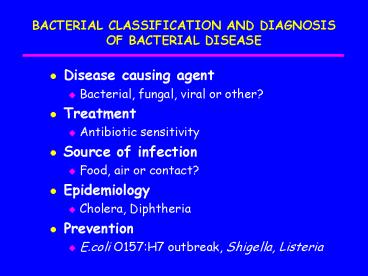BACTERIAL CLASSIFICATION AND DIAGNOSIS OF BACTERIAL DISEASE - PowerPoint PPT Presentation
1 / 48
Title: BACTERIAL CLASSIFICATION AND DIAGNOSIS OF BACTERIAL DISEASE
1
BACTERIAL CLASSIFICATION AND DIAGNOSIS OF
BACTERIAL DISEASE
- Disease causing agent
- Bacterial, fungal, viral or other?
- Treatment
- Antibiotic sensitivity
- Source of infection
- Food, air or contact?
- Epidemiology
- Cholera, Diphtheria
- Prevention
- E.coli O157H7 outbreak, Shigella, Listeria
2
Antibiotic sensitivity
3
Site of sampling
- Sterile sites
- Blood
- Celebrospinal fluid (CSF)
- Body fluids (Peritoneal and pleural)
- Non-sterile (normal flora)
- Respiratory tract
- Ear, eye and mouth
- Skin (wound and abscess)
- Urine (mid-stream)
- Feces
4
Bacterial classification
- Wall structure
- Gram
- Staphylococcus, Streptococcus, Clostridium,
Bacillus - Gram -
- Enteric, respiratory and others
- Acid-fast
- Mycobacterium
- Wall-less
- Mycoplasma
- Unusual
- Obligate intracellular
- Rickettsia, Chlamydia, Treponema
5
Bacterial classification
- Cell morphology
- Shapes
- Rod
- Cocci
- Spiral
- Associations
- Individual
- Diplo-
- Staphylo-
- Strepto-
- Filaments
6
Gram stains
7
Gram Stains of Mixtures
8
Cell shapes
9
Bacterial classification
- Growth characteristics
- Oxygen requirement
- Aerobic
- Anaerobic
- Microaerophilic, aerotolerant
- Facultative
- Spore formation
- Intracelular/extracellular
- Fastidious/non-fastidious
10
Endospore
11
Classification Diagnosis
- Type of colonies
- Appearance
- Color, shape, size and smoothness
- On differential media
- Blood, MacConkey, EMB, Manitol salt agar
- On selective media
- MacConkey, EMB, Manitol salt agar
12
Colony morphology/color
13
Bacterial colony morphology
14
Capsule
15
MacConkey Agar Plate
16
Blood Agar Plates and Hemolysis
17
Mannitol salt agar
18
Classification Diagnosis
- Metabolism
- Utilization of specific substrates
- Lactose (Sal/Shi/Yer/)-
- Citrate (E.coli-/Klebsiela)
- Production of certain end products
- Fermentation end products
- Acid (acetate, propionic acid, butyric acid etc.)
- Aceton
- Alcohol
- Amine
- H2S
19
Triple Sugar Iron Agar Slants
- TSI
- Fermentation of glucose, lactose, and/or sucrose
- Reduction of sulfur to hydrogen sulfide
- Gas formation
- Used for Enterobacteriaceae
20
Classification Diagnosis
- Specialized tests
- Immunological
- O-, H- K-Ag (serotype)
- Precipitation, agglutination
- Specialized enzymes
- Catalase--- Staph. vs. Strep-.
- Coagulase---S. aureus vs. S. epidermidis-
- Oxidase---Neisseria gonorrhoea
- Urease---Proteus, Helicobacter
- Antibiogram pattern
- Phage typing
- Fatty acid profile
21
Urease Test
H2O
Urea
CO2 NH3
NH4 OH-
22
Indole Test
23
API test strip
24
Bacteriophage Plaques
25
Conventional method
- Depend on ability to culture
- Treponema pallidum
- Slow, esp. for fastidious species
- Mycobacterium spp.
- Not always definitive
26
Immunological detection
27
Instant View tests
28
Molecular diagnosis
- Ribotyping
- Restriction fragment length polymorphism (RFLP)
- DNA hybridization
- PCR, RT-PCR and RAPD
- Nucleic acid sequence analysis
- Phage-GFP (TB)
29
RFLP
GGATCC CCTAGG
30
DNA hybridization
31
In situHybridization
32
PCR
Rate of increase 2n
33
Real time PCR
34
RAPD of P. aeruginosa
35
DNA and protein chips
36
Microarray array mediated pathogen detection
37
Ab chip mediated pathogen detection
?-O157H7
E.coli O157H7
?-Salmonella
?-O157H7
Salmonella typhimurium
?-Salmonella
38
Molecular diagnosis
- Reduce reliance on culture
- Faster
- High sensitive
- More definitive
- More discriminating
- Techniques adaptable to all pathogens
- Technically demanding
- Relatively expensive
- Can be too sensitive
- Provides no information if results are negative
39
Bioterrorism
- Pathogen detection
- Fast and accurate
- Mobile
- Inexpensive
- Source investigation
40
Biosensor Mediated Pathogen Detection
Step 1 Attach Capture Antibody to Fiber Optic
Waveguide
Step 2 Apply Sample. Target Organism Binds to
Waveguide
Step 3 Wash Away Other Cells and Debris
41
Biosensor Mediated Pathogen Detection
Y
Y
Y
Y
Y
Y
Y
Y
Y
Y
Y
Y
Y
Y
Y
Y
Y
Y
Y
Step 1 Attach Capture Antibody to Fiber Optic
Waveguide
Step 2 Apply Sample. Target Organism Binds to
Waveguide
Step 3 Wash Away Other Cells and Debris
Step 4 Add Specific Detection Antibody
Step 5 Turn on Laser. Detection Antibody
Fluoresces, Indicating a Positive Sample.
42
Biosensors
Analyte 2000TM for laboratory research and
development
RAPTORTM automated version for field analysis
43
Differentiating Staphylococci from Streptococci
- Gram stain and morphology
- Both Gram
- Staphylococci bunched cocci
- Streptococci chained cocci
- S. pneumoniae diplococcus
- Enzyme tests
- Staphylococci catalase
- Streptococci catalase -
- Growth
- Staph. large colonies (non-fastidious), some
hemolytic - Strep. small colonies (fastidious), many
hemolytic (? or ?)
44
Staphylococci
- S. aureus coagulase
- S. epidermidis coagulase -
45
Streptococci
46
Differentiating the Gram- bacteria
- Cocci
- Neisseria
- Rods
- Type of disease they cause
- Enteric Gram- rods
- API test
- Curved
- Vibrio, Campylobacter, Helicobacter
- Spiral Gram- organisms
- Spirochetes
47
Gram negative
Curved rods
Straight rods
Lactose Lactose-
TCBS agar Yellow Oxidase Vibrio
Campy blood agar 42oC 25oC- Campylobacter
Citrate Citrate-
H2S H2S-
Klebsiella E.coli Salmonella
Shigella
48
Bacteria































